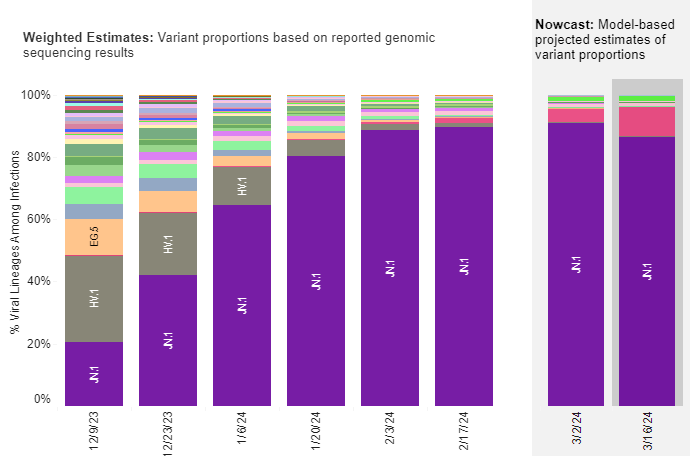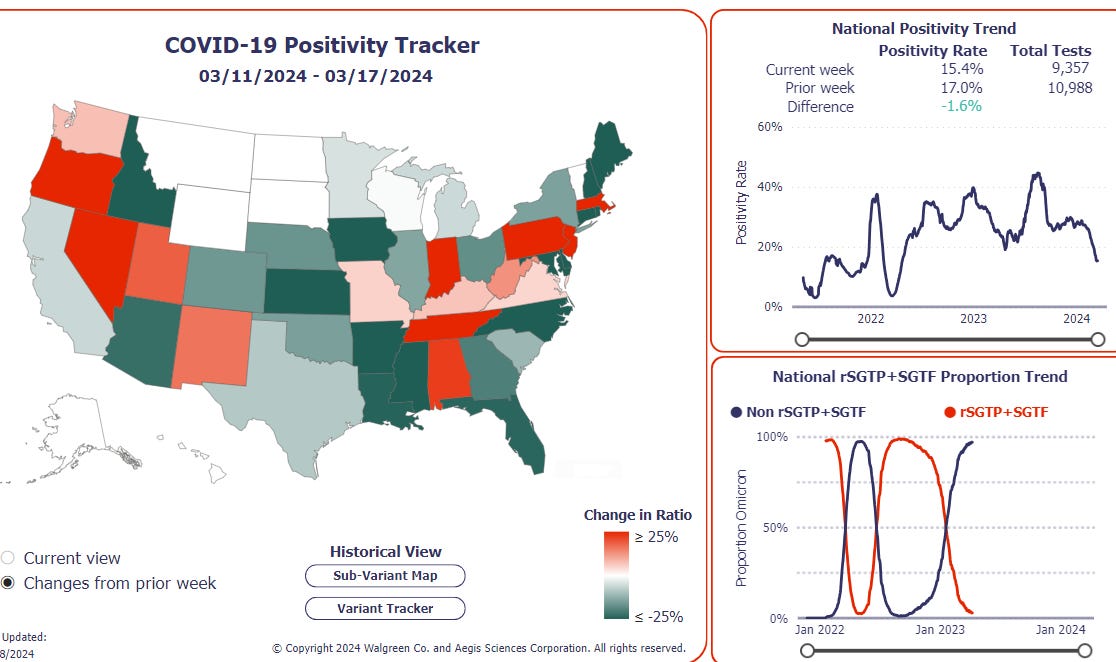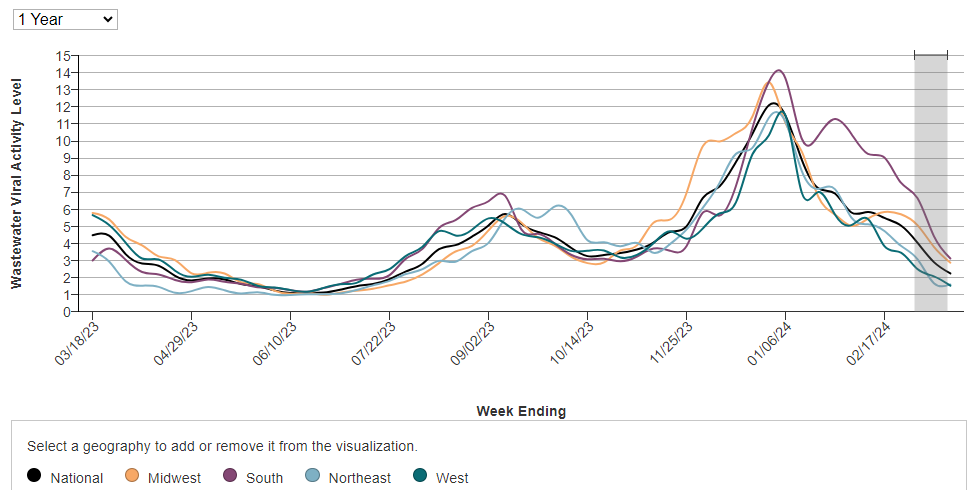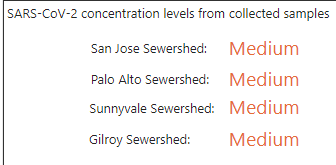We are now nationally at a “LOW” level of SARS-CoV-2 virus in wastewater according to the CDC. Here in Santa Clara Valley, wastewater COVID levels are “Medium”. Sara Anne Willette’s wastewater map shows that there are no states with “Excessive” or “Very High” levels of SARS-CoV-2 this week. Only New Jersey and Utah show “substantial” virus levels in wastewater.
COVID infections have decreased rapidly this week. Overall, test positivity is down to 4.6% per the CDC (and 15.4% per Walgreen’s who offers free COVID testing at their pharmacies). Emergency department visits for COVID and hospitalizations are down 25.6% and 20.9% respectively this week.
Hospitalizations (blue) and ED visits (orange): https://covid.cdc.gov/covid-data-tracker/index.html#datatracker-home
On March 22, JP Weiland estimated that we were at 340,000 new infections/day in the United States, with 1 in every 98 people currently infected with COVID. That is a huge improvement from January. JN.1 and its descendants account for almost all COVID cases in the U.S. now. A study this week shows that higher levels of JN.1 are shed in the stool than for other variants. This could make cases seem higher than they are since we rely on wastewater levels of SARS-CoV-2 virus to calculate the number of cases in a population. According to the study, JN.1 did not cause more gastrointestinal symptoms despite the higher shedding. Higher fecal viral shedding makes me wonder if JN.1 could lead to an increased percentage of people with viral reservoirs in their gut which could potentially lead to Long COVID.
From: https://twitter.com/JPWeiland/status/1771302511275565361
From wastewater data, Jay Weiland predicts that the average American has had COVID 2.7 times so far. More infections happened in 2022 because Omicron and its descendants including BA.1, BA.2, BA.5, and BQ were able to sidestep our immunity.
Yesterday, the FDA approved a new monoclonal antibody called Pemgarda for pre-exposure prophylaxis (PrEP) for COVID-19 in moderate to severely immunocompromised people aged 12 and older. It is given intravenously every 3 months. Pemgarda was not approved for treatment of acute COVID infection or for post-exposure prophylaxis after exposure to a person with COVID. Only 623 people received Pemgarda in the clinical trials and 4 of 623 (0.6%) of participants had anaphylaxis to Pemgarda. I would like to see more data.
AstraZeneca’s prophylactic monoclonal antibody drug Evusheld was taken off the market in January 2023 when it became ineffective against Omicron variants. Rumour is that FDA approval is pending on another AstraZeneca long acting monoclonal antibody for pre-exposure prophylaxis against SARS-CoV-2 called Sipavibart (AZD3152).
A new study in Nature looked at pathways related to strong viral replication in ACE2+ lung cells during early acute infection and local and systemic inflammatory responses via ACE2- myeloid cells (ACE2 independent entry into myeloid cells) in later stages of acute COVID infection. Regarding diagnosis of COVID using lung ultrasound images and AI, authors found that “deep neural networks (DNNs) trained with simulated and in vivo data are promising alternatives to training with only real or only simulated data when segmenting in vivo COVID-19 lung ultrasound features.”
SARS-CoV-2 infection can cause myocarditis and heart damage even if the virus does not infect the heart cells themselves. Inflammation from a severe COVID infection in the lungs from Acute Respiratory Distress Syndrome (ARDS) causes indirect heart damage by expanding the CCR2+ macrophage subset.
A surprisingly hard-to-read paper in Nature magazine reported that in Southwest China, patients with psoriasis and prior vaccination with inactivated and recombinant protein type vaccines did not need to stop their psoriasis medications if they were exposed or infected with COVID. Since vaccination types are different in the United States, these findings may or may not be applicable here.
A small study from Austria shows that SARS-CoV-2 was detected in the eyes of some patients infected with COVID at lower levels than was found in nasopharyngeal swabs. In patients with high SARS-CoV-2 viral load, lacrimal fluid (tears) were found to sometimes be infectious.
In patients undergoing in vitro fertilization (IVF) who had a COVID infection, SARS-CoV-2 virus was detected in the follicular fluid from some patients. In addition, COVID infection negatively impacted egg quality by delaying early embryonic development. Fewer oocytes were produced in SARS-CoV-2-infected infertile patients undergoing IVF as well. It is expensive to cancel an IVF cycle if someone gets sick with COVID, but because of embryo development issues, it may be worth canceling that cycle.
Economics of COVID and Long COVID
Two articles discussed the effect of Long COVID on economic growth in England. An article in the Daily Mail stated that “Britain is suffering its longest sick note epidemic for 25 years as 2.7 million people claim they are too ill to work and holding back the country's economic growth in the process.” Costs for healthcare and disability benefits are forecasted to rise to £90.9 billion by the end of the decade according to the Office for Budget Responsibility. Another economic analysis in Cambridge Econometrics shows that Long COVID is putting pressure on economic growth and the NHS.
Vaccines
Multisystem Inflammatory Syndrome in Children (MIS-C) is a rare but serious multiorgan disease that usually occurs 2–6 weeks after SARS-CoV-2 infection. Most cases of MIS-C in 2023 were in unvaccinated children or in children whose immunity had waned over time. The CDC recommends that “up-to-date COVID-19 vaccinations are important to protect against complications like MIS-C.”
Natural killer cells (NK) are a type of white blood cell in the innate immune system that kill cancer cells and cells that are infected by viruses. A new study shows that some people are genetically predisposed to myocarditis after mRNA COVID vaccines because of their natural killer (NK) cells. People with myocarditis after vaccination were found to have elevated serum cardiac troponin T (cTnT) concentrations which was related to an increase in CD57+ NK cells compared to the vaccinated non-myocarditis control group.
A new study shows that there was no evidence of an elevated risk for stroke after vaccination with either of the bivalent mRNA COVID vaccines distributed for the 2022-2023 respiratory season. The culprit of an increased stroke risk appears to actually have been due to the high-dose flu vaccine and the adjuvanted flu vaccine that was given to some older adults during the 2022-2023 season.
Long COVID and the Brain
Using the UK Biobank data, researchers compared 26,101 people with SARS-CoV-2 infection, to 380,337 contemporary controls with no evidence of infection and 390,621 historical controls predating the pandemic. People who had a COVID infection, including breakthrough COVID infections, were at increased risk of long term psychiatric disorders. Unvaccinated people and those who had severe acute COVID infections were at highest risk.
From: https://www.nature.com/articles/s41562-024-01853-4
The hippocampus is a part of the brain that helps short term memories to become long term ones. It is also important in emotional processing such as anxiety and avoidance behaviors. Proton magnetic resonance spectroscopy (1H-MRS) and whole brain MRI was used to look at the hippocampus both before and after COVID infection in three people. Mild COVID infection was noted to be associated with local neuroinflammation and reduced glutamate levels in the hippocampus of people with Long COVID. “1H-MRS findings may have clinical value for explaining chronic neurological and psychological complaints in COVID-19 long-haulers."
An article in Nature this week reviewed four recent studies on COVID and the brain. Helena Radbruch’s lab found that inflammation caused by COVID infection of other organs could trigger direct neuroinflammation in cranial nerve nuclei and a diffuse pattern of inflammation in the entire brainstem. A study from Ireland used dynamic contrast-enhanced magnetic resonance imaging (DCE-MRI) to show that leaky blood vessels in the blood brain barrier could allow toxic and inflammatory molecules into the brain, causing brain damage and brain fog. The third article is a preprint that looked at possible direct infection of brain cells by SARS-CoV-2 and the fourth article showed that SARS-CoV-2 can cause senescence (aging) of dopamine neurons in the brain.
Long COVID clinical trials
The NIH RECOVER-AUTONOMIC clinical trials have opened and will be looking at treatments for Postural Orthostatic Tachycardia Syndrome (POTS) related to Long COVID. Treatments to be tested include IVIG and Ivabradine. The Bateman Horne Center is enrolling Long COVID patients in a Phase 2 clinical trial of valacyclovir and celecoxib.
In non-COVID news, two-thirds of children under age 6 in Chicago were exposed to lead in their drinking water. Drinking 8-ounces daily of soda or fruit juices was found to raise boys’ odds for Type 2 diabetes. The New York Times made an excellent video on how prior authorizations are being used by health insurance companies to block patients from getting treatments that their doctors have deemed necessary.
Metformin is a Type 2 diabetes drug that reduces blood sugar and can cause weight loss, but its mechanism of action was poorly understood. New studies show that Metformin causes a significant elevation of the appetite-suppressing metabolite N-lactoyl phenylalanine (Lac-Phe) in the blood.
A new study showed that 93% of Parkinson’s patients were found to have phosphorylated α-synuclein on skin biopsy. Further studies are needed to understand if skin biopsies can be used as a biomarker for Parkinson’s and other synucleinopathies.
Have a good rest of your weekend,
Ruth Ann Crystal MD
COVID news notes:
US Variant tracker: https://covid.cdc.gov/covid-data-tracker/#variant-proportions
Variants in locations around the globe: https://outbreak.info/
CDC COVID data tracker: https://covid.cdc.gov/covid-data-tracker/index.html#datatracker-home
CDC COVID Hospitalizations (blue) and Emergency Room (orange) visits tracker: https://covid.cdc.gov/covid-data-tracker/index.html#trends_weeklyhospitaladmissions_7dayeddiagnosed_00
Weekly ED visits for respiratory illnesses, by age and disease: https://www.cdc.gov/ncird/surveillance/respiratory-illnesses/index.html
Walgreens positivity rate: https://www.walgreens.com/businesssolutions/covid-19-index.jsp
US Wastewater Monitoring:
CDC wastewater reporting: https://www.cdc.gov/nwss/rv/COVID19-nationaltrend.html
CDC wastewater map: https://www.cdc.gov/nwss/rv/COVID19-currentlevels.html
Biobot: https://biobot.io/data/
National SARS-CoV-2 data from Sara Anne Willette: https://iowacovid19tracker.org/
Wastewater SCAN: https://data.wastewaterscan.org/
California statewide view https://buff.ly/3YObiul
Sewer Coronavirus Alert Network (SCAN) project by Stanford University:
Santa Clara County wastewater: https://covid19.sccgov.org/dashboard-wastewater
JP Weiland: https://twitter.com/JPWeiland
https://twitter.com/JPWeiland/status/1771302511275565361
March 22nd update from JP Weiland:
Infection levels continue to decline rapidly.
A year ago, both wastewater levels AND positivity rate were 47% higher than they are today.
340,000 new infections/day
1 in every 980 became infected today
1 in every 98 people currently infected
https://twitter.com/JPWeiland/status/1763712303864926633
Variants
3/21/24 Lancet Infectious Disease: Increased fecal shedding in SARS-CoV-2 variants BA.2.86 and JN.1 https://buff.ly/4cv1vQq
“Both BA.2.86 and JN.1 show higher rates of viral shedding compared with XBB.1.5, EG.5.1, HV.1, and JD.1.1, including in presymptomatic and vaccinated individuals, which might partly explain the increase in wastewater levels.
“Although JN.1 is known for greater transmissibility and immune evasion, none of our cohort had severe digestive illnesses from JN.1, although it might contribute to more efficient gut tissue infection.”
Acute COVID infections, General COVID info
3/22/24 FDA: Frequently Asked Questions on the Emergency Use Authorization for Pemgarda (pemivibart) for Pre-exposure Prophylaxis (PrEP) of COVID-19 https://buff.ly/4a0PAbc
Pemgarda, made by Invivyd, is a long acting monoclonal antibody drug that can be given to people age 12 and older prophylactically for moderate to severe immunocompromise. It is not approved for treatment of acute COVID infection or for post-exposure prophylaxis after exposure to a person with COVID.
Pemgarda will be given iv every 3 months for prophylaxis.
Only 623 people have received Pemgarda so far in clinical trials and 4 of 623 (0.6%) of participants had anaphylaxis to Pemgarda.
AstraZeneca’s Evusheld prophylactic monoclonal antibody drug was taken off the market in January 2023 when it became ineffective against Omicron variants.
AstraZeneca has another long acting monoclonal antibody against SARS-CoV-2 called Sipavibart that is expected
According to the NCI, “A long-acting neutralizing human monoclonal antibody derived from B-cells of convalescent patients with severe acute respiratory syndrome coronavirus-2 (SARS-CoV-2) infection and directed against SARS-CoV-2, that can potentially be used for passive immunization against Coronavirus disease 2019 (COVID-19). Upon administration, sipavibart neutralizes SARS-CoV-2. This may slow the progression of the disease and accelerate recovery, and may potentially provide temporary protection against infection with SARS-CoV-2.”
https://ncit.nci.nih.gov/ncitbrowser/ConceptReport.jsp?dictionary=NCI_Thesaurus&code=C200075&ns=ncit
Draft CHMP Agenda 11-14 December 2023
https://www.ema.europa.eu/en/documents/agenda/agenda-chmp-meeting-11-14-december-2023_en.pdf
8.1.2. Sipavibart - H0006291 Pre-exposure prophylaxis of COVID-19 Scope: Briefing note and the Rapporteurs’ recommendation on the request for accelerated assessment.
Action: For adoption
mAbs for Immunocompromised people: https://twitter.com/tomlins_amanda/status/1771415626445476007
3/22/24 STAT News: FDA authorizes new monoclonal antibody drug Pemgarda to protect vulnerable from Covid-19 https://buff.ly/3INFMFF
3/21/24 Nature Cell Biology: ACE2-dependent and -independent SARS-CoV-2 entries dictate viral replication and inflammatory response during infection https://buff.ly/3Vr6tHC
"molecular insights into the mechanisms by which strong viral replication but scarce inflammatory response during the early (ACE2-dependent) infection stage, followed by low viral replication and potent inflammatory response in the late (ACE2-independent) infection stage, may contribute to COVID-19 progression."
Figure 8e:
Early stage of acute COVID infection: SARS-2 infection and viral replication in ACE2+ respiratory epithelial cells
Late stage of acute COVID infection: Local and systemic inflammatory response via ACE2- myeloid cells (ACE2 independent entry into myeloid cells).
3/20/24 Healio: Virus that causes COVID-19 can damage heart even if heart tissue not directly affected https://buff.ly/4cnNgfX
Inflammation from a COVID infection in the lungs (ARDS) can cause indirect heart damage even if the virus does not attack the heart directly.
3/20/24 Circulation: Virus-Induced Acute Respiratory Distress Syndrome (ARDS) Causes Cardiomyopathy Through Eliciting Inflammatory Responses in the Heart https://buff.ly/3vqoJX1
Autopsy specimens from 21 patients with COVID-19 with SARS-CoV-2–associated ARDS. Mice studies also done.
SARS-CoV-2 increased total cardiac macrophage counts and led to a higher proportion of CCR2+ (C-C chemokine receptor type 2 positive) macrophages.
3/20/24 Nature: COVID’s toll on the brain: new clues emerge https://buff.ly/3VuqixH
Review of 4 recent studies on COVID and the brain:
Inflammation
Leaky blood-brain barrier
Direct infection of brain cells by SARS-CoV-2
Senescence of dopamine neurons in the brain
3/15/24 Nature: Prevalence, outcomes and associated factors of SARS-CoV-2 infection in psoriasis patients of Southwest China: a cross-sectional survey - Scientific Reports https://buff.ly/4aiV1BW
This study was hard to read.
February 2023 to March 2023 in Southwest China.
Vaccines were mostly inactivated (2-dose) and recombinant protein (3-dose) vaccines.
“Patients treated with psoriasis shown to be safe, without a higher incidence of SARS-CoV-2 infection or COVID-19 hospitalization compared to untreated patients. Stopping treatment during SARS-CoV-2 infection led to psoriasis exacerbation, so psoriasis treatment could be continued except severe adverse reaction.”
3/11/24 Nature: Detection of COVID-19 features in lung ultrasound images using deep neural networks https://buff.ly/49THb9v
Deep neural networks (DNNs) were used to detect COVID-19 features in lung ultrasound B-mode images.
“Conclusion: DNNs trained with simulated and in vivo data are promising alternatives to training with only real or only simulated data when segmenting in vivo COVID-19 lung ultrasound features.”
3/5/24 American Journal of Reproductive Immunology: SARS‐CoV‐2 infection negatively impacts on the quality of embryos by delaying early embryonic development https://buff.ly/3TqH7qJ
65 infertile patients infected with SARS-CoV-2 and 258 controls undergoing IVF
"the number of oocytes and high-quality embryos on day 3 dramatically reduced in SARS-CoV-2-infected infertile patients. SARS-CoV-2 was detected in the follicular fluid of three infertile patients. SARS-CoV-2 infection had negatively impacted the number of oocytes in multivariate linear regression models. The early embryonic development in the SARS-CoV-2 infection group had a noticeable delay from the six-cell stage to blastocyst stage."
'SARS-CoV-2 infection negatively impacts on the quality of embryos by delaying early embryonic development'
3/4/24 Frontiers in Cellular and Infection Microbiology (Austria): Detection of infectious SARS-CoV-2 in ocular samples is linked to viral load in the nasopharynx https://buff.ly/492hmCI
May 2020 and April 2021, ocular and nasopharyngeal swabs were collected from 28 hospitalized SARS-CoV-2 infected patients in Innsbruck, Austria.
SARS-CoV-2 was detected in the eyes of some of the infected patients albeit at lower levels compared to nasopharyngeal swabs.
In patients with high SARS-CoV-2 viral load, lacrimal fluid (tears) can sometimes be infectious.
Social and Advocacy
3/20/24 Cambridge Econometrics (UK): New economic analysis reveals Long Covid could be a long-term drag on economic growth and add pressure to already strained NHS https://buff.ly/3TOjkCo
"Long Covid is likely to reduce GDP by around £1.5bn and 138,000 jobs each year. Were prevalence to increase to 4 million people per year by 2030, the negative impacts would increase to a reduction of around £2.7bn in GDP and 311,000 job losses each year."
3/22/24 Daily Mail:
Britain is suffering its longest sick note epidemic for 25 years as 2.7MILLION people claim they are too ill to work and holding back the country's economic growth in the process https://buff.ly/3TusOBA
Number of employees claiming sickness has risen for four-and-a-half years
Longest sustained trend since the late 1990s when it rose to around 2.4million
Spending on benefits is forecast to rise to £90.9billion by the end of the decade
Pediatrics
3/14/24 CDC: Surveillance for Multisystem Inflammatory Syndrome in Children — United States, 2023 https://buff.ly/3ToGXQL
MIS-C is still happening mostly in unvaccinated children or whose immunity has waned over time.
More than 80% (92 of 112) of MIS-C cases were in vaccine-eligible but unvaccinated children, and among the 20 vaccinated children, 60% likely had waned immunity at the time of MIS-C illness.
Vaccines
Natural killer cells (NK) are a type of white blood cell in the innate immune system that kill cancer cells and cells that are infected by viruses.
This study shows that some people are genetically predisposed to myocarditis after mRNA COVID vaccines because of their natural killer (NK) cells.
3/22/24 Med (Hong Kong): The central role of natural killer (NK) cells in mediating acute myocarditis after mRNA COVID-19 vaccination https://buff.ly/43yBQSz
“NK cell activation by mRNA COVID-19 vaccine contributed to the pathogenesis of acute myocarditis in genetically and epidemiologically vulnerable subjects.”
Abundance of the CD57+ NK subset was particularly prominent in males and in those after the second dose of vaccination.
Genotypically, killer cell immunoglobulin-like receptor (KIR) KIR2DL5B(−)/KIR2DS3(+)/KIR2DS5(−)/KIR2DS4del(+) was a risk haplotype, in addition to single-nucleotide polymorphisms related to the NK cell-specific expression quantitative trait loci DNAM-1 and FuT11, which also correlated with cardiac troponin T levels in post-vaccination patients with myocarditis.
Biochemical testing showed elevated serum cardiac troponin T (cTnT) concentrations in patients when compared to the vaccinated non-myocarditis control group (p < 0.0001).
Elevated serum NK-stimulatory cytokines found in vaccine-related myocarditis
CD57+ NK cell abundance positively correlates with the elevated cTnT level
CD57+ NK cells are more frequent in males and after second vaccine dose administration
Genetic mechanisms in NK cell activity impact vaccine-related myocarditis risk
3/19/24 JAMA: Stroke Risk After COVID-19 Bivalent Vaccination in US Older Adults https://buff.ly/3TWxhi1
Early stroke signal originally linked to bivalent COVID-19 vaccines may instead be linked to high-dose flu vaccine.
“found no evidence of a significantly elevated risk for stroke at 1-21 days or 22-42 days after vaccination with either of the mRNA COVID vaccines distributed for the 2022-2023 respiratory season when compared with the 43-90 day control window, reported researchers.”
However, they “found that people with administration of a high-dose or adjuvanted influenza vaccine alone (without concomitant COVID vaccination) had an elevated risk for the combined outcome of nonhemorrhagic stroke or transient ischemic attack in both the 1-21 days risk window (risk difference of 1.65 per 100,000 doses) and 22-42 days risk window (risk difference of 1.60 per 100,000 doses).”
“Among Medicare beneficiaries aged 65 years or older, the primary analysis showed no evidence of a significantly elevated stroke risk during the days immediately after administration of either brand of the COVID-19 bivalent vaccine.”
Long COVID and the Brain
3/22/24 MRI: Hippocampal neurometabolic and structural changes from pre-to post-COVID-19: A case-series study https://buff.ly/4alSabA
Proton magnetic resonance spectroscopy (1H-MRS) may be applied to detect neurochemical abnormalities in COVID-19 long-haulers.
Whole brain magnetic resonance imaging (MRI) images and proton magnetic resonance spectroscopy (1H-MRS) of the left hippocampus were collected before and after COVID infection in 3 people.
Biomarker ?:
"mild COVID-19 infection could be associated with development of local neuroinflammation and reduced glutamate levels in the hippocampus. Our 1H-MRS findings may have clinical value for explaining chronic neurological and psychological complaints in COVID-19 long-haulers."
3/21/24 Nature Human Behaviour: Long-term risk of psychiatric disorder and psychotropic prescription after SARS-CoV-2 infection among UK general population https://buff.ly/4a3H7E2
Using the UK Biobank data, researchers compared SARS-CoV-2 infection (n = 26,101) to contemporary control with no evidence of infection (n = 380,337) and historical control predating the pandemic (n = 390,621).
People who had a COVID infection, including breakthrough COVID infections, were at increased risk of long term psychiatric disorders especially in unvaccinated people or in people who had severe acute COVID infections.
"With the accumulation of breakthrough infections in the post-pandemic era, the findings highlight the need for continued optimization of strategies to foster resilience and prevent escalation of subclinical mental health symptoms to severe disorders."
NIH RECOVER-AUTONOMIC clinical trials have opened. https://trials.recovercovid.org/autonomic
RECOVER-AUTONOMIC is studying possible treatments for adults who have an autonomic nervous system disorder, called Postural Orthostatic Tachycardia Syndrome (POTS), related to Long COVID.
Study Group A: IVIG or Placebo
Study Group B: Ivabradine or Placebo
In addition to the study drugs IVIG and ivabradine, RECOVER-AUTONOMIC is studying possible coordinated non-drug treatments, like making diet changes and wearing a compression belt around the stomach.
https://twitter.com/BatemanHorne/status/1770842490737741918
Phase II of the Valacyclovir + Celecoxib study is enrolling for Long COVID patients.
AI:
From above
3/11/24 Nature: Detection of COVID-19 features in lung ultrasound images using deep neural networks https://buff.ly/49THb9v
“Conclusion: Deep neural networks (DNNs) trained with simulated and in vivo data are promising alternatives to training with only real or only simulated data when segmenting in vivo COVID-19 lung ultrasound features.”
Other news:
3/20/24 JAMA: Skin Biopsy Detection of Phosphorylated α-Synuclein in Patients With Synucleinopathies https://buff.ly/3J8gN01
Skin biopsy can diagnose Parkinson's disease and other synucleinopathy diseases.
N = 428 participants, cutaneous phosphorylated α-synuclein detected by skin biopsy in:
92.7% with Parkinson disease (PD)
98.2% with multiple system atrophy (MSA)
96.0% with dementia with Lewy bodies (DLB)
100% with pure autonomic failure (PAF)
3.3% with no history of synucleinopathy (controls).
3/20/24 HealthDay: Sodas, Fruit Juices Raise Boys' Odds for Type 2 Diabetes https://buff.ly/3PshowL
Each daily 8-ounce serving of sugary drinks during a boy’s childhood is associated with a 34% increase in insulin resistance by the time they are teens.
Girls did not display the same risk.
Nearly two-thirds of U.S. kids and teens consume at least one sugary drink – soda, lemonade, energy drinks and the like – every day, according to the American Heart Association.
3/18/24 Many Chicago children exposed to lead in tap water, study estimates https://buff.ly/43xy7ER
About two-thirds of children younger than 6 years old in Chicago are exposed to lead in their drinking water, representing 129,000 young children.
3/18/24 Nature Metabolism: Metformin and feeding increase levels of the appetite-suppressing metabolite Lac-Phe in humans https://buff.ly/3ILXZTN
Metformin causes a significant elevation of the appetite-suppressing metabolite N-lactoyl phenylalanine (Lac-Phe) in the blood in seven studies.
Lac-Phe levels increased after metformin dose and after meals in people with T2D and controls.
3/18/24 Nature Metabolism: Metformin induces a Lac-Phe gut–brain signaling axis https://buff.ly/495FV1C
Metformin reduces blood sugar and can cause weight loss.
Two studies link metformin to the appetite-suppressing metabolite N-lactoyl-phenylalanine, which is made by the intestine.
3/14/24 NY Times: ‘What’s My Life Worth?’ The Big Business of Denying Medical Care With Prior Authorizations https://buff.ly/3Tg1O8L
https://www.nytimes.com/2024/03/14/opinion/health-insurance-prior-authorization.html
Prior authorizations block patients from getting treatments that their doctors have deemed necessary.
Wikipedia: Anna Muzychuk is a Ukrainian grand master chess player. In 2017, she boycotted the World Rapid and Blitz Championships over FIDE's decision to hold the events in Saudi Arabia because of the country's discriminatory policies against women.



































Thank you for your outstanding newsletters. I wonder if you could have a section on International Covid news, including levels of Covid. Would be super helpful for travelers
Thank you again and again!